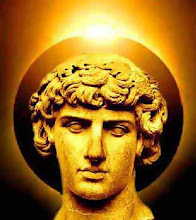In The Beginning
Was the Word …
Now Come the
Drawings
For the better part of the Christian era in Western civilization, illustrating scenes from the Bible was not a job for artists. It was the job. As late as the Renaissance, Michelangelo, Leonardo, and their wannabes spent their days illustrating ceilings and altarpieces, painting frescoes, and chiseling images of Moses, David, and Madonna and child out of every scrap of available marble. But as the church lost some of its hold on the Western imagination, artists felt free to look elsewhere for inspiration. Now and then an artist would undertake a religious theme (Chagall, Rouault), but excepting the English painter Stanley Spencer or outsider artist Howard Finster, it's hard to think of a major modern artist who's spent much time on holy ground. It's even harder to think of an artist who could significantly alter our perceptions of the events, previously illustrated or not, in the Bible. But then, who could have foreseen that R. Crumb would tackle the Book of Genesis?
The artist credited with almost singlehandedly launching the underground-comics scene in '60s San Francisco, the cartoonist who gave us the X-rated adventures of Fritz the Cat and Mr. Natural, a professed atheist, a man who fantasizes about getting piggyback rides from big-legged women (and then draws and publishes these fantasies), and, last but surely most horrifying to the people whose nightmares Crumb haunts, an American who emigrates to France and likes it—this is the man a publisher has entrusted with the task of illustrating the first book of the Bible.
Unlikely as it might seem, this was trust well repaid. Without a trace of irony, and certainly no mockery, Crumb delivers a literal—one might even say traditional—rendition of the events in the Judeo-Christian account of Creation and its aftermath. Frame by frame, comic-book fashion, The Book of Genesis shows a white-bearded, patriarchal God creating the heavens and the earth and all that walk upon it. We see Adam and Eve exiled from the Garden of Eden. We observe the first murder, as Cain kills his brother, and then Noah and the Flood, the travails of Abraham—every verse of every chapter carefully rendered, right through to the story of Joseph and the Israelite migration to Egypt.
What distinguishes this version is its meticulous realism. The beginning is a little spongy—through no fault of Crumb's: there are, after all, two overlapping and not entirely synchronous Creation myths in the opening pages—but as soon as the story reaches solid ground, that is, as soon as Adam and Eve are banished from the garden, the narrative finds its footing. We see the story as we read it, and what we see are camels and grizzled, hairy-legged herdsmen, watering troughs and tents delineated right down to every flap and peg, women laboring through childbirth, bowls and stoppered jugs, dusty towns and the towering palace of the pharaoh. Abraham and his descendants move through a sun-baked, unforgiving landscape, earning their crust through the sweat of their brows, and the visual precision with which their struggles are rendered endows them with a nobility only hinted at in the text. God may not be in the details, but his chosen people surely are.
It is one thing, for example, to read that Abraham and Sarah were old and childless. It is altogether different to watch them age and to witness the sadness in their faces at the thought of childlessness. As drawn by Crumb, Abraham and his descendants are not just figures in a story. First and last, they are fully human and full of frailty. When God orders Abraham to slaughter his son, Isaac, we see a horrified—and angry?—old man and a helpless, tearful boy, and suddenly what has always been an unsettling tale becomes truly horrific. This has always been a story about faith being tested, but there is nothing abstract about Crumb's version. Instead, his realism restores the mystery at the heart of the tale: how could a man believe in something so strongly that he would kill the child he wanted more than anything else?
Even the most famously tedious passages—those genealogical lists familiarly known as "the begots"—become fascinating when Crumb supplies thumbnail sketches of every man listed, instilling a vivid sense of humanity in what is, on the page, merely a list of names. It is one more instance of the artist's ability to make us see that, however shrouded by time, these were people before they were part of an oft-told tale. This version of Genesis works so well because it is not reverential. The artist always honors the story, never dodging or minimizing the occasions when God or one of his emissaries enters the action, but by keeping everything as grittily real as possible, Crumb achieves a miracle all his own: he makes one of the world's oldest stories new again.
![Reblog this post [with Zemanta]](http://img.zemanta.com/reblog_e.png?x-id=4f654cb0-9626-8b4c-a60a-991eff9cd65f)







